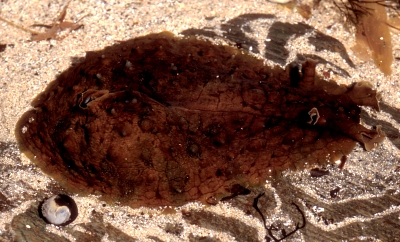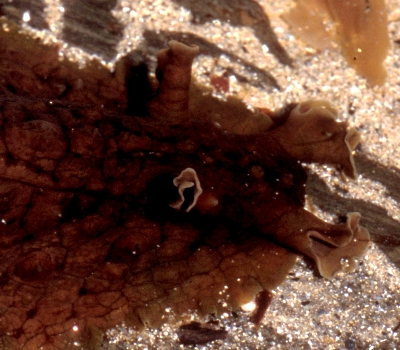Dolabrifera brazieri from eastern Victoria
February 7, 2007
From: John Eichler

Dear Bill
I thought this photograph of a dark brown coloured Dolabrifera brazieri might be of interest since the other images on the Forum show mottled animals. It was one of three specimens (the other two were mottled) observed at Cape Conran in February 2006, and follows the discovery of a single specimen there a year earlier (see message #13766 ). Egg ribbons were also observed in February 2006. Is it reasonable to assume that the species is established at Cape Conran? These records appear to represent a range extension from southern NSW - based on advice from Museum Victoria and local expert, Bob Burn and the lack of any posted responses to your 2005 request for other Victorian observations.
Locality: East Cape, Cape Conran, intertidal, Victoria, Australia, Bass Strait, 26 February 2006, Rocky intertidal (mudstone). Length: About 130 mm. Photographer: John Eichler.
Regards
John Eichler
john.eichler@frankston.vic.gov.au
Eichler, J.G., 2007 (Feb 7) Dolabrifera brazieri from eastern Victoria. [Message in] Sea Slug Forum. Australian Museum, Sydney. Available from http://www.seaslugforum.net/find/19381
Dear John,
The brown colour of your animals certainly makes me wonder if in this species colour pigments from their algal food is being incorporated in their skin. As this species seems to survive quite well in aquaria it would be a nice little project for someone - but the first step would be to find out which algae it does eat.
Concerning your question about whether this species is established at Cape Conran. I suspect this is the southern extreme of its range and its occurrence is dependent on planktonic larvae arriving from further north at an appropriate time. In Sydney we sometimes have great populations of the tropical Chelidonura inornata and C. fulvipunctata, but they are there for a few months and then disappear. I wouldn't describe them as 'established species'. The concept of 'established species' is more appropriate for terrestrial species and marine species in which the offspring and parent populations are found together. In marine species with free-swimming larvae, the parent population is often far away from the juveniles.
Best wishes,
Bill Rudman
Related messages
-
Re: Large tubercled ?Aplysia at Little Bay, Sydney
From: Kirsten Crosby, March 19, 2010 -
Sea slug? from Clovelly, Sydney
From: Eve Jary, March 18, 2010 -
Dolabrifera brazieri from Mooloolaba, QLD
From: Gary Cobb, August 28, 2008 -
Dolabrifera brazieri at Bateau Bay, New South Wales
From: Deb Gorgievski, August 22, 2008 -
Dolabrifera brazieri from New South Wales
From: Krista Rankmore, January 23, 2007 -
Dolabrifera brazieri with opaline gland secretions
From: Sascha Schulz, September 14, 2005 -
Dolabrifera brazieri from Victoria, Australia
From: John Eichler, May 13, 2005 -
Dolabrifera brazieri from New Zealand
From: Ross Armstrong, February 21, 2004 -
Dolabrifera brazieri from Lord Howe Island
From: W.B. Rudman, April 26, 2003 -
Dolabrifera brazieri from Lord Howe Island (2)
From: W.B. Rudman, April 26, 2003 -
Dolabrifera brazieri from Swansea, eastern Australia
From: Simon Voorwinde, April 26, 2003 -
Dolabella brazieri from northern New South Wales
From: Bill Rudman, April 26, 2003 -
Dolabella brazieri from southern New South Wales
From: Bill Rudman, April 26, 2003 -
Dolabrifera dolabrifera & D. brazieri
From: Bill Rudman, April 26, 2003
